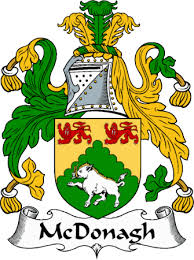
MCDONAGH
This is an Anglicized form of the Olde Gaelic patronymic "Mac Donnchadha". The Gailic prefix "m(a)c" means "son of", plus the personal name Donnchadha, a compound of the elements "donn" meaning "brown", plus "cath", a battle. Two separate septs of the M(a)c Donaghs existed in Ireland. The first belonged to the Connacht counties of Sligo and Roscommon. These M(a)c Donaghs were a branch of the great MacDermots (8th Century Kings of Connacht). The chiefs of the family were Lords of Tireril in Co. Sligo. The second sept, whose chiefs held the castle of Kanturk and were known as Lords of Duhallow, were a branch of the MacCarthys. Andrew MacDonagh (born 1738) accompanied Wolfe Tone in the Bantry Bay expedition of 1796. Thomas MacDonagh (1878 - 1916) was a leader of the Easter Rising (1916) and a signatory of the Declaration of Independence. The first recorded spelling of the family name is shown to be that of MacDonnagh which was dated 1659, in "Petty's Census of Ireland", during the reign of Richard Cromwell, known as "The Lord Protector", 1658 - 1660. Surnames became necessary when governments introduced personal taxation. In England this was known as Poll Tax. Throughout the centuries, surnames in every country have continued to "develop" often leading to astonishing variants of the original spelling.
They were mainly located in Counties Galway, Cork and Sligo where the majority of descendants can still be found. Variants include MacDonogh, Donaghy and McDonough.
Our side of the McDonagh's are mainly in Dublin, Co. Dublin, Ireland

Meaning of Symbols & Colors on the
McDonagh Coat of Arms
| Gules/Red | 'The Martyr's colour', signifies Military Fortitude and Magnanimity. | |
| Or/Yellow/Gold | Represents Generosity. | |
| Vert/Green | Signifies Hope, Joy and sometimes, Loyalty in Love | |
| Boar | Represents the bearing of a Warrior | |
| The Lion | Emblem of Deathless Courage |
Mick McDonagh and Abigail Gray
2012
 designed and maintained by Sean McDonagh
designed and maintained by Sean McDonagh